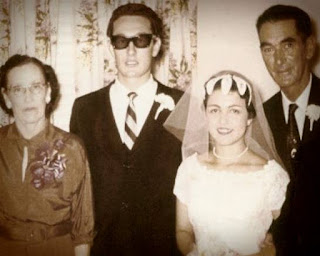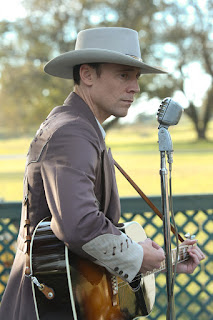Honoring the 57th anniversary of the plane crash that took the lives of Buddy Holly, The Big Bopper, and Ritchie Valens. It provides three radio promos recorded by the artists themselves that advertise their last tour. Then, two newscasts of the plane crash that happened on Feb. 3, 1959 during that same tour.
BUDDY HOLLY KILLED IN UNEXPLAINED PLANE CRASH: On this day in 1959, rock and roll legend Buddy Holly was killed when his plane slammed into an Iowa cornfield in a blinding snow storm. Ritchie Valens and disc jockey "The Big Bopper" died with him. They were in the middle of the "Winter Dance Party" tour, flying to their next date in Minnesota. No one is exactly sure what went wrong.
Holly may be best known for his iconic black-framed glasses, which were chosen for the singer by optometrist J. David Armistead. Armistead later went on to serve as a board member at the University of Houston. Those same glasses were among the items that went missing in the plane crash, until they were found in a Mason City, Iowa cornfield on February 29, 1980. Holly's glasses and a number of other artifacts are now on display at the Buddy Holly Center in Lubbock, Texas. Source: Eyewitnessnews
The Last Day: A look at the final day of a Rock n' Roll legend.
Bill Griggs: Ellis Amburn ("Buddy Holly - A Biography") and Philip Norman ("Buddy Holly – Rave On") came to me within a few months of each other. They each received the same information available at that time. When their respective books were published, it seemed they wrote about two different people. How can that be? By the way, Amburn's book really belongs in the trash can. Still the best overall read in my opinion is the one by John Goldrosen. Philip Norman had access to much of the newly discovered paperwork from Clovis. Larry Lehmer discovered some brand new facts. Amburn was interviewed on English radio shortly after it came out. He was asked what places he went to in Lubbock and who he talked to. His reply was, "I didn't go to Lubbock." So where and how did he get his information?
Lance Monthly: The Boston rock ‘n’ roll riots in 1958, which came about from the reported violence at one of Alan Freed’s shows, not only led to the decline of Alan Freed himself, but the damnation of rock ‘n’ roll with FBI Director, J. Edgar Hoover leading the charge. What are your thoughts on this?
Bill Griggs: Alan Freed took the dive for Boston, and shouldn't have. He ultimately left New York, and after gigs in Florida and California, found himself totally out of work. He died, they say, of a broken heart. Did payola kill rock 'n' roll, as we knew it? Probably. The whole era was exciting because, musically, we had all those independent producers and record labels and almost anyone with a good song--and some with bad songs--could get a record released. After payola, this sorta changed and the majority of those independent producers and labels all but disappeared. The movie "American Hot Wax" really captured the feeling of an Alan Freed concert and a great quote came out of that movie. When the police were trying to shut down his concert, Tim McIntire (as Alan Freed) stated, "You can stop the concert. You can stop me... but you can't stop rock 'n' roll. Don't you know that?"
Lance Monthly: Did you have a chance to meet and interview Waylon Jennings before he passed away? What was your impression of him, and why did Holly pick him to play bass on his final tour when it seems that he could have easily found a musician with better bass skills?
Bill Griggs: I knew Waylon and we got along just fine. Each time we'd talk about Buddy, a smile would come over his face, and then he'd get serious. You see, after all those years had gone by, he still fondly remembered his mentor--the person who really believed in him. I was talking to Waylon in 1979 just before he gave a concert in Lubbock. I asked him if he was going to sing his song "Old Friend" that mentions Buddy. He got very serious, then his tears welled up and he said, "Bill, if I did that, I wouldn't be able to get past the first verse."
Lance Monthly: In Ellis Amburn’s Holly biography, he states that when Ed Sullivan invited Holly back for a third appearance on Ed’s show for double the pay, Buddy refused because of Sullivan’s "wrecking of "Oh Boy" during his previous appearance. What are your thoughts on this?
Bill Griggs: Although I have many problems with things that Mr. Amburn wrote, this part is true. When Buddy and his group was in rehersal for his second appearance on January 26, 1958, Ed Sullivan told him that the show was going to run long and Buddy would have to do only one song. Sullivan then informed Buddy that "Oh Boy" was "too raunchy" and that Buddy should do something else. Buddy told Ed Sullivan that he had promised his friends back home that he'd do "Oh Boy," so it would be that song or nothing. Ed Sullivan introduced Buddy as Buddy Hollard. To get even, during the break of the song, Buddy and the guys double-timed their playing and played as loud as they could. What you don't see is what happened as soon as the song was completed and the Crickets exited the stage. The camera went back to Ed Sullivan and he was mad! He looked as if he had swallowed a bird. The Ed Sullivan staff did call Buddy about making a third appearance and he said no. When they called back, Buddy was offered double the money for a third appearance. Buddy angrily said something like, "I don't need you or your show" and hung up. Source: www.musicdish.com
“There’s not a week that goes by that I don’t play my Buddy Holly's songs.” —Keith Richards, “Buddy Holly: Rave On” DVD




























































